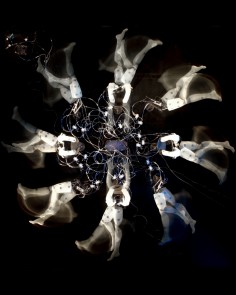PETER WILLIAM HOLDEN
arabesque
source: highlike
Work: Arabesque: Mechancical kaleidoscope Dimensions; 450 x 450 x 150 cm. Materials; Composite plastic, Computers, Compressed Air Components. In my recent work I have concerned myself not only with the sculpting of three dimensions but also with a fourth: the dimension of time. I have attempted to create work that evolves, adapts and regresses. Work which falls somewhere between conventional notions of pictorial art and a kind of performance. “Arabesque” is the natural continuation of this exploration – a real time animation. With its roots in Mary Shelly’s “Frankenstein” (1818) and the alchemist’s laboratory, the installation presents itself as a mechanical flower: a simulacrum of nature. Life sized human body parts, impaled upon steel, move and sway and dance. The limbs, translucent and livid, bare their internal robotic mechanisms to the gaze of the viewer. The wiring itself is an aesthetic expression deliberately integrated into the installation to bring chaotic lines of abstract form to contrast with the organized symmetry of the body parts. The lifeblood of this organism is air when activated air flows invisibly, bestowing movement to these mechanisms and its presence is only betrayed when exhaled loudly from the valves attached to the serpentine air hose.This combined with the rattle of relays and the tandem clattering of pistons to produce a hyper-modern accompaniment to the music of Strauss. Part cinema, part theatre, “Arabesque” can be viewed form a multitude of angles, revealing a multitude of different forms, different patterns and different experiences of the piece. A kaleidoscope of beautiful shapes and patterns created from the human form.
Photographer: Matthias Möller / Medial Mirage
.
.
.
.
.
.
.
source: peter-william-holden
Like many of my generation I grew up suckling on a cathode ray tube and bathing in radio waves. All this is depicted within my work, in a collage of movement, light and sound.
Currently with my work I am exploring ways of dissolving the boundaries between cinematography and sculpture. My recent investigations of this theme have involved the usage of computers combined with mechanical elements to create mandala like installations. These installations are my medium and I use them to create ephemeral animations. This ephemeral choreography of movement is the focal point of my work.
I believe this fascination with moving imagery and the transformation of objects stems from my youth where early home computers of the 1980s gave me a glimpse into the wonderful world of applied mathematics. On these computers it was possible with simple codes to generate fantastic abstract patterns and sounds and that encounter destroyed forever the boundary in my mind between abstract and real.
Dance also plays a significant role in my work; I was drawn to it through electronic music. Electro with its synthesized sound introduced me to break-dance and my soul was captured by the beauty of choreographed physical movement.
.
.
.
.
.
source: rhizomeorg
I was born in a decaying industrial town in Northern England in 1970 and like many of my generation I grew up suckling on a cathode ray tube and bathing in radio waves. All this is depicted within my work, in a collage of movement, light and sound.
Currently with my work I am exploring ways of dissolving the boundaries between cinematography and sculpture. My recent investigations of this theme have involved the usage of computers combined with mechanical elements to create mandala like installations. These installations are my medium and I use them to create ephemeral animations. This ephemeral choreography of movement is the focal point of my work.
I believe this fascination with moving imagery and the transformation of objects stems from my youth where early home computers of the 1980s gave me a glimpse into the wonderful world of applied mathematics. On these computers it was possible with simple codes to generate fantastic abstract patterns and sounds and that encounter destroyed forever the boundary in my mind between abstract and real. Dance also plays a significant role in my work; I was drawn to it through electronic music. Electro with its synthesized sound introduced me to break-dance and my soul was captured by the beauty of choreographed physical movement.
.
.
.
.
.
.
source: rhizomeorg
In my recent work I have concerned myself not only with the sculpting of three dimensions but also with a fourth: the dimension of time. I have attempted to create work that evolves, adapts and regresses. Work which falls somewhere between conventional notions of pictorial art and a kind of performance. “Arabesque” is the natural continuation of this exploration – a real time animation.
With its roots in Mary Shelly’s “Frankenstein” and the alchemist’s laboratory, the installation presents itself as a mechanical flower: a simulacrum of nature. Life sized human body parts, impaled upon steel, move and sway and dance. The limbs, translucent and livid, bare their internal robotic mechanisms to the gaze of the viewer. The wiring itself is an aesthetic expression deliberately integrated into the installation to bring chaotic lines of abstract form to contrast with the organized symmetry of the body parts.
The lifeblood of this organism is air and when activated this air flows invisibly, bestowing movement to these mechanisms and its presence is only betrayed when exhaled loudly from the valves attached to the serpentine air hose. This combined with the rattle of relays and the tandem clattering of pistons to produce a hyper-modern accompaniment to the music of Strauss.
Part cinema, part theatre, “Arabesque” can be viewed form a multitude of angles, revealing a kaleidoscope of beautiful shapes and patterns created from the human form.


